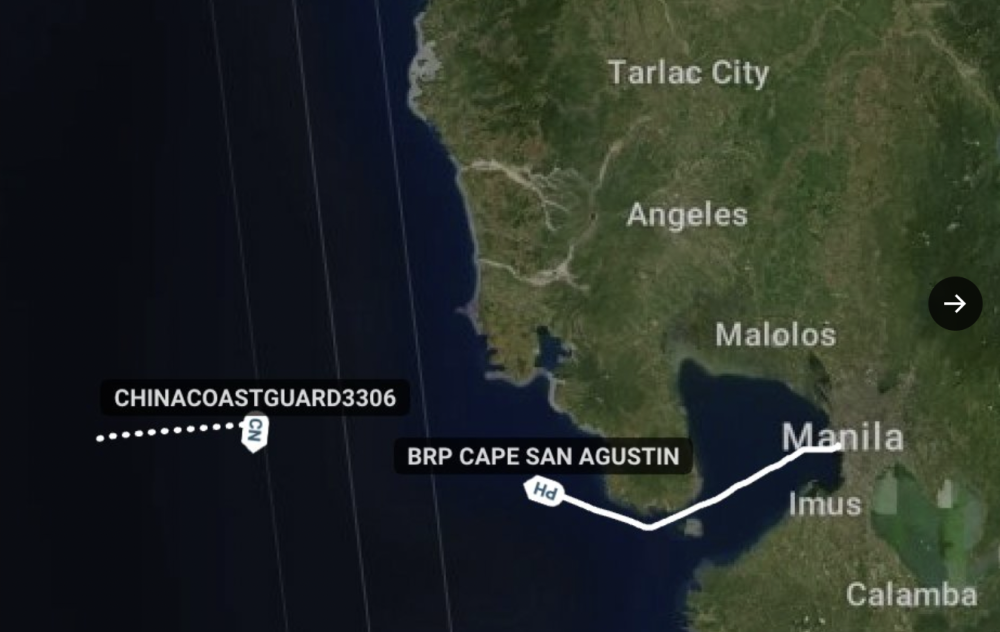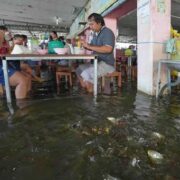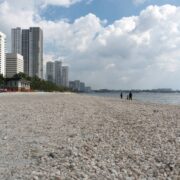PH challenges China Coast Guard vessel off Zambales

A Philippine Coast Guard (PCG) vessel on Friday shadowed a China Coast Guard (CCG) ship detected west of Zambales province, in what maritime monitoring group SeaLight described as “highly unusual” proximity for Beijing’s maritime forces.
At a press conference, Commodore Jay Tarriela, the PCG spokesperson for the West Philippine Sea, said BRP Cape San Agustin (4408) challenged CCG 3306 early Friday after spotting it about 107.51 kilometers (58 nautical miles) off Capones Island in Zambales, and 138.9 km (75 nautical miles) from Panatag (Scarborough) Shoal.
The ship, Tarriela clarified, never entered Manila Bay and, at its closest, was 55.56 km (30 nautical miles) from Zambales.
“It is the Philippine Coast Guard that is actually challenging and monitoring the presence of 3306,” Tarriela said, noting that the two ships were about 7.408 km (4 nautical miles) apart. He said Cape San Agustin was on its way to Panatag, also known as Bajo de Masinloc, while the CCG vessel’s mission remained unknown.
He said it would not be safe to assume both vessels were headed to the same location.
This development came four days after the collision of Chinese vessels off Panatag in their bid to stop the Philippine government’s outreach program for local fishermen.
‘As close as they get’
On Monday, CCG 3104 chased the PCG’s BRP Suluan and performed a risky maneuver on the PCG ship, leading to a collision with a People’s Liberation Army Navy (PLAN) warship with hull number 164. Both ships were damaged, with CCG 3104’s forecastle being badly crushed, while BRP Suluan managed to evade the maneuver, according to the PCG.
The sighting on Friday was first flagged by SeaLight, which reported that CCG 3306 appeared positioned to intercept the Philippine vessel as it headed toward the West Philippine Sea.
SeaLight founder Ray Powell said Chinese coast guard ships typically operate farther offshore.
Powell, program head of Stanford University’s Gordian Knot Center for National Security Innovation, earlier told the Inquirer that CCG 3306 was “sitting just outside” the 44.44-km (24 nautical-mile) contiguous zone, and not within the Philippines’ archipelagic waters
“China Coast Guard waits just outside Manila Bay for it (BRP Cape San Agustin) to emerge,” Powell said on X (formerly Twitter).
“China seems determined to intercept and escort any Philippine ship moving in Scarborough Shoal’s general direction,” he added.
Powell noted that it was not the first time a CCG ship had come that close to Manila Bay. “It’s as close as they get, but I’ve seen them get that close before,” he added.
Misleading
Tarriela, however, cautioned against describing the location as “near Manila Bay,” saying such references could be misleading.
The PCG said four other CCG ships—3105, 4202, 4305 and 3305—remain strategically deployed 44.44 km (24 nautical miles) from Bajo de Masinloc, guarding the shoal’s northwest, west, southwest, and southeast approaches.
Three other CCG vessels earlier reported by Powell—4203, 4301 and 3502—have since moved farther away, with distances ranging from 307.43 km to 442.62 km (166 nautical miles to 239 nautical miles) from the shoal.
As of 3:30 p.m. Friday, CCG 3306 was spotted 109.08 km (58.90 nautical miles) away from Pundaquit village in San Antonio, Zambales, still at a close distance with Cape San Agustin, spotted 102.37 km (55.33 nautical miles) from the same area, according to Tarriela.
“The presence of 4408 (Cape San Agustin) actually caused [CCG] 3306 to depart from its location,” he said at a press conference.
Tarriela found issues in using Manila Bay as a point of reference for the Chinese ship’s location.
“The problem is, he’s (Powell) actually using Manila Bay, the mouth of Manila Bay, as a point of reference. But in reality, if you look at it, it’s really far,” Tarriela said. “That’s why I keep on mentioning, we always measure it from Bataan or even from Cavite or even Mindoro (Island). Because it’s much more rational if you’re going to use that as a landmark to measure its location.”
Research vessel
“Secondly, if you’re going to use Manila Bay as a point of reference, it will attract so much attention from the public,” he went on. “But in reality, it’s not really inside Manila Bay or it’s not that close from Manila Bay.”
Manila Bay is located in the western part of Luzon facing the West Philippine Sea and is bounded by Cavite province and Metro Manila on the east, Bulacan and Pampanga provinces on the north, and Bataan province on the west and northwest.
In what Powell called a “surprising and unusual development,” China also deployed the research ship Xiang Yang Hong 10 a kilometer south of Panatag on Friday.
The research ship is capable of deep-sea surveying, resource exploration and deploying autonomous underwater vehicles.
Earlier, Powell said he did not know the reason behind the survey ship’s presence. But later, he tracked that Xiang Yang Hong 10 repositioned to the mouth of Panatag, “perhaps intending to deploy people and equipment into the shoal’s interior.”
“One reason for this is to see if it is recovering from over a decade of highly destructive giant clam harvesting,” he said.
China, he said, ended the practice last year while issuing a report about how the shoal was in great condition. “At SeaLight we believe that is a lie,” Powell said.
Tarriela said Xiang Yang Hong 10 returned this week to the vicinity after a sharp turn toward Palawan following its departure from Guangdong, China, in late June. He said the vessel had loitered in the area in late July, although its activities remained unclear.
Tarriela said Beijing continued to normalize the presence of its coast guard off Zambales, Pangasinan, and even the Ilocos provinces.
He stressed that the PCG “will never allow such normalization of illegal patrol.”
DFA: Not responsible
Meanwhile, the Department of Foreign Affairs (DFA) on Friday maintained that it had no responsibility over the collision of two Chinese vessels.
In fact, the DFA said, it is China who still owes the Philippines, including payment for damages and illegally seized military equipment and personal belongings, for a collision last year at Ayungin (Second Thomas) Shoal, in another part of the West Philippine Sea off Palawan province.
“The (Philippines) bears no responsibility for the collision between the PLAN vessel and the CCG vessel in Bajo de Masinloc,” the DFA said in a statement. “It was an unfortunate outcome, but not one caused by our actions.”
DFA spokesperson Angelina Escalona clarified that Beijing has not formally asked the Philippine government for any form of compensation for the recent incident.
Chinese Ministry of National Defense spokesperson Jiang Bin on Friday accused the PCG vessels of “intruding” into Panatag, which Beijing calls “Huangyan Dao,” on Aug. 11.
“The China Coast Guard vessels took measures in accordance with law to track, monitor, block and dispel these Philippine vessels,” Jiang said in a statement issued by the Chinese Embassy in Manila. —WITH A REPORT FROM KATHLEEN DE VILLA

















